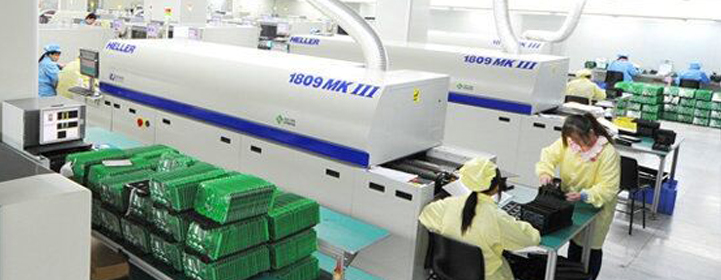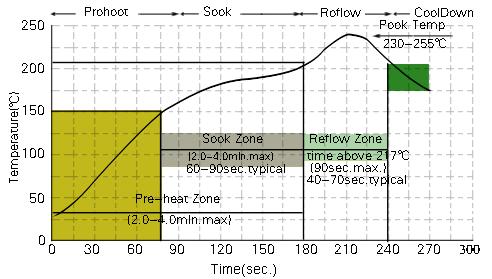2-5 Solder Paste Operation Manual
Home> 2-5 Solder Paste Operation Manual

2-5 Solder Paste Operation Manual
2-5 Solder Paste Operation Manual
2-5-1 Shelf Management
1)Store the paste between 0℃ to 10℃(4℃ to 8 ℃ is the best). It will take at least 3 hours to recover to room temperature after cold storage in the refrigerator.
2)Churn up the paste before use. 5 minutes are required in by automatic churning machine and 10min by hand.
3)Ensure that only the bottle of paste being used is open. This is intended to keep the paste fresh for future use and reduce the negative impact of the environment. Tighten the cap, both inner and outer, after use to prevent the solder paste from drying or being oxidized, therefore extending the service life of the product.
4)Use the paste according to the principle of FIFO.
5)Make sure the paste rolling continuously during printing operation. Keep the height equal to 1/2~3/4 of the scraper's. Monitor the viscosity of solder paste in the process. Smooth rolling can be conducive to transfer the paste to the underlying the stencil opening, thus a finer pattern..
6)Transfer the printed PCB to the next procedure as soon as possible (within 1 hour), to prevent solder paste from drying and viscosity degradation.
7)Don't leave the paste on PCB more than 1 hour to avoid clogging the PCB.
8)Collect the used paste with a new container to avoid old solder paste affecting the property of the new. Please refer to the corresponding requirements when dealing with used paste storage. Used paste and fresh paste mixed up in a ratio of 1:3 can be equal to the totally fresh one in property.
2-5-2 Screen Print Parameters
1) Scraper Speed: normally 10-150mm/s.
Being too fast could cause the scraper to slide or miss printing while being too slow may lead to uneven edges and taint the substrate surface.
2) Angle of the Scraper Fixation: In the range of 60°-90°, appropriate printing pressure acquired from adjustment to the angle could reach the best printing and transferring efficiency.
3) Printing Pressure: 0.1-0.3kg/c㎡.
Low pressure could lead to insufficient amount of transferring paste, and high pressure may result in undesirably thin paste layer and increase the chance of tainting the substrate surface. Please increase the pressure from the minimum gradually until it's just able to scrape off the paste from the surface of slat.
4) Hardness and Material of the Scraper: hardness 80-90 HS; material, stainless steel or rubber.
2-5-3 Cautions
1) Please read the MSDS before operation.
2) Avoid any direct contact with the solder paste by skin and clothes. If it happens, sweep off the paste with alcohol solvent immediately.
3) Avoid inhalation of steam during reflowing operation.
4) Wash hands after soldering operation and before dinner.
2-5-4 Temperature Profile Parameters:
Applied to Sn63∕Sn62-Ag2 solder pastes

1) Preheat Zone: The highest temperature is 2.5℃/s. Excessive rising rate will cause solder-balling.
2) Soaking Zone: Keep the temperature within the range of 149-180℃/s and the temperature rising rate less than 2.5℃/s during the soaking zone, which lasts regularly from 60s to 90s.
3) Reflow Zone: The peak temperature in the reflowing zone changes in the range of 215-235℃ Make sure the temperature stays above 180℃ for 45-60S
4) Cool-Down Zone: The temperature dropping rate during cool-down zone should be kept under 4℃/s。
Note: The curve varies according to shape of the plate and function of the devices. The circumstance parameter is suggested to be 25±2℃ by temp. and 45%-65% by humidity.
2-5-5 Recommend Reflow Soldering Temperature Profile
Applied to WH-326 WH-373 solder pastes

1) Preheat Zone: The highest temp.is 2.5℃/s in pre-heating area. Over rising rate will cause solder-balling.
2) Soak Zone:Keep the temp. within the range of 150-210℃ and the temp. rising rate under 2.5℃/s during the soaking zone. Which lasts regularly from 60s to 90s
3) Reflow Zone: The peak temp. in the reflowing zone changes in the range of 230-255℃. Temperature stays above 217℃ for 40-70S
4) Cool-Down Zone: The temperature dropping rate during cool-down zone should be kept under 4℃/s。
Note: The curve varies according to shape of the plate and function of the devices. The circumstance parameter is suggested to be 25±2℃ by temp. and 45%-65% by humidity.
Technical supports
Contact us
Address:Xingfa Road,Balitai Industrial Zone,Jinnan District,Tianjin,PR China
Tel:86-022-83981122
Fax:86-022-83981133
Email:zhongyasolder@zhongyasolder.cn

 English
English 中文简体 | 中文繁体
中文简体 | 中文繁体 




